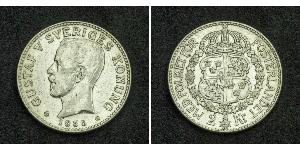| 2 Крона Швеция Серебро Гу ... > История > Изменение |
| Дата изменения | 2015-04-20 22:14 (older) | 2015-04-20 22:16 (newer) |
| Добавил | ||
| Состояние изменения | Проверенно | Проверенно |

|

|
|
| Номинал | 2 Крона | 2 Крона |
| Страна | Швеция | Швеция |
| Год(а) выпуска | 1939 | 1939 |
| Металл | Серебро | Серебро |
| Личность | Густав V (1858 - 1950) | Густав V (1858 - 1950) |
| Категории | ||
| Ссылка на каталог | ||
Описание -
 Русский
Русский
|
Швеция 2 кроны (1939 г.) Серебро G. Густаф V. Номер по Краузе # 787, 800-я проба, 15 г. | Швеция 2 кроны (1939 г.) Серебро G. Густаф V. Номер по Краузе # 787, 800-я проба, 15 г. |
Описание -
 English
English
|
KM# 787 |
1936, Sweden, Gustaf V. Nice Silver 2 Kronor Coin. aXF! Mint Year: 1910 Obverse: Head of Gustaf V of Sweden.
Gustaf V (Oscar Gustaf Adolf 16 June 1858 – 29 October 1950) was King of Sweden from 1907. He was the eldest son of King Oscar II of Sweden and Sophia of Nassau, a half-sister of Adolphe, Grand Duke of Luxembourg. Reigning until his death at age 92, he holds the record of being the oldest monarch of Sweden and the second-longest reigning (after Magnus IV). He was also the last Swedish monarch to wield actual political power. Ascending to the throne in 1907, his early reign saw the rise of parliamentary rule in Sweden, although the leadup to World War I pre-empted his overthrow of Liberal Prime Minister Karl Staaff in 1914, replacing him with his own figurehead Hjalmar Hammarskjöld (father of Dag Hammarskjöld) for most of the war. However, after the Liberals won a majority under Staaff's successor, Nils Edén, he allowed Edén form a new government which de facto stripped the monarchy of its virtual powers and had enacted universal and equal suffrage, including for women, by 1919. Accepting the principles of parliamentary democracy, he remained a popular figurehead for the remainder 31 years of his rule, although not completely without influence – in the days of World War II he allegedly urged Per Albin Hansson's cabinet to accept calls from Nazi Germany to logistics support which, if refused, might have pre-empted an invasion, and remains controversial to date. Only 1$ shipping for each additional item purchased! |


